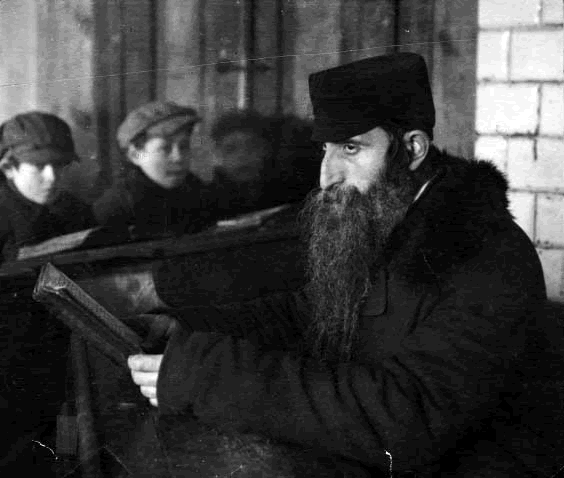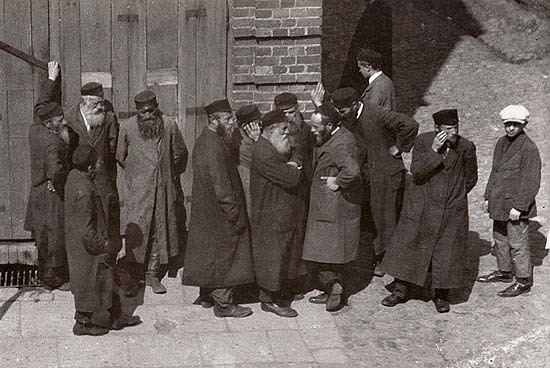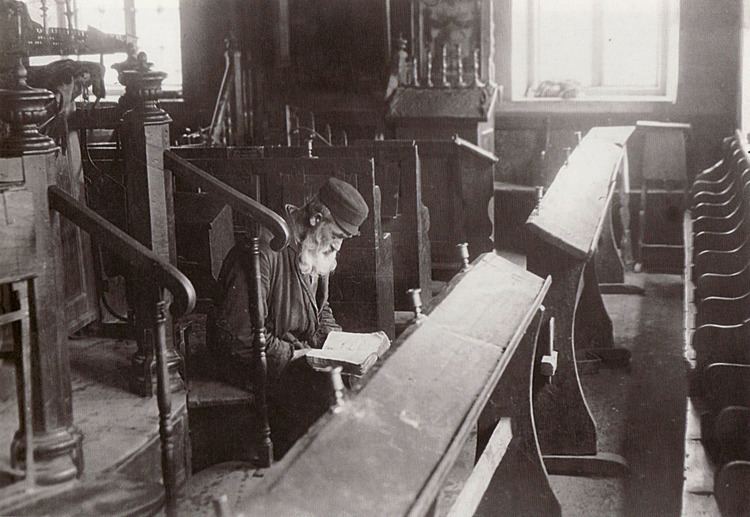Nationality Lithuanian Spouse Khana Kacyzne Occupation Photographer, writer Movies The Dybbuk | Name Alter Kacyzne Children Sulamita Kacyzne Role Writer Books Poyln | |
 | ||
Similar People S Ansky, Michal Waszynski, Anatol Stern | ||
31 May 2013
Alter Kacyzne (May 31, 1885 in Vilnius, Russian Empire – July 7, 1941 in Ternopil, General Government for the Occupied Polish Territories) was a Jewish (Yiddish) writer, poet and photographer. One of the most significant contributors to Jewish-Polish cultural life in the first half of the 20th century. Among other things, he is particularly known as a photographer whose work immortalised Jewish life in Poland in the 1920s and 1930s.
Contents

Biography

Alter-Sholem Kacyzne was born on the 31st of May, 1885, to a poor working-class family in Vilna in Imperial Russia (now Vilnius in Lithuania), within the Pale of Settlement. His father worked as a bricklayer, and his mother worked as a seamstress. He was educated in a Cheder and in the Russian-Jewish school. He spoke Yiddish at home. An avid reader, he taught himself Hebrew, Russian, Polish, German and French.

Following the death of his father in 1899, when Kacyzne was fourteen, he went to work as an apprentice in his uncle's professional photography studio in Ekaterinoslav, New Russia (now Dnipropetrovsk, Ukraine). While engaged in self-education, he began to write short stories in Russian. He wrote poems and sent some of these to the Yiddish author S. Ansky. Around this time he married Khana Khachnov. In 1910, greatly attracted by the Yiddish works of I.L. Peretz, he moved to Warsaw to be closer to the teacher. He became a member Peretz's circle, and an ardent literary disciple.
Kacyzne opened a photographic studio in Warsaw. In the 1920s, he worked as a photojournalist for the New York City-based newspaper Forverts (Forward). He travelled as a photographer to Poland, Romania, Italy, Spain, Palestine and Morocco. In the years 1927-1928 Kacyzne's photographs, accompanied by his travel essays, were published in the Warsaw magazine "Our Express".
His work as a photographer was combined with his literary work. As a critic and essayist, he published articles on literary and social issues in Warsaw and Vilna. He was co-editor of several journals. In the early 1920s the founded the literary series "The Ark" (Di Teyve, 1920, together with David Einhorn), short-lived magazines "Bells" (Glokn, 1921) and "The Links" (Ringen, 1921-1922, in cooperation with Michal Veiherte ). In 1924 he became co-founder of the magazine "Literary Pages" (Literarishe Bleter, 1924-1939; together with Israel Joshua Singer, Peretz Markish, Melehom Ravichem and Nachman Mayzilem). In 1930 he participated in newspapers with a communist orientation: "Literary Tribune" (Literarishe Tribune; 1930-1933), "Tribune" (1934), "Comrade" (Der Fraynd, 1934-1935, Yiddish: דער פֿרייַנד), "Literature" (Literatur; 1935) In 1937-1938, he issued the fortnightly magazine, "My film speaks"» (Mayn redndiker film), the contents of which were critical articles, translations and satires.
In 1939, after the Nazi occupation of Poland he fled with his family to Lviv . He became in charge of the literary section of the Lviv State Jewish Theater. While there, Sholem Aleichem worked on the radio.
Kacyzne tried to escape Nazi persecution in Poland and moved to Ternopil in 1941. By the time he arrived the Nazis had already occupied the city. He was beaten to death by Ukrainian collaborators during an attack on the town's Jewish population (pogrom - 7 July 1941). His wife Khana was murdered in Belzec extermination camp, while his daughter Sulamita survived by hiding in Poland as a non-Jew.
Photography
Arriving in Warsaw in 1910, Kacyzne opened his own photography studio. Originally it was located on Długa street; the address changed several times. Kacyzne worked at portraits, shooting memorable events (weddings, bar mitzvah), and soon became a well-known photographer. The turning point in his professional career as a photographer began in 1921, when he was commissioned by a charitable organisation based in the United States of America the Hebrew Immigrant Aid Society (HIAS) to make a series of images dedicated to the life of Jews in Polish cities and towns, including the eastern lands that were part of the territory of Poland - Galicia and Volyn (Kacyzne travelled to more than 120 Polish settlements). These images so impressed Abraham Cahan, Chief Editor of the New York newspaper "Forward", that he suggested that Kacyzne document Jewish life in Poland for readers.
Kacyzne's precious historical collection was almost entirely destroyed during the Nazi occupation; only a selection of 700 photographs survived. After the Holocaust, the imagery acquired not only artistic but also historical value, documenting the pre-war life of the Polish Jewish community.These photographs, which are an important part of Kacyzne's work, are now kept in the YIVO Archive (Institute for Jewish Research) in Manhattan and in the Bibliothèque Medem of Paris.
